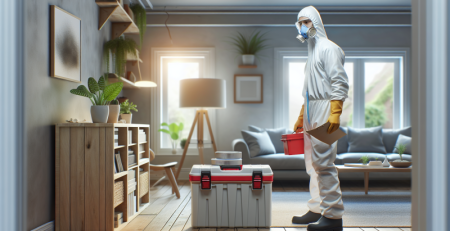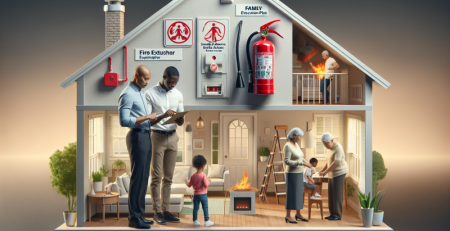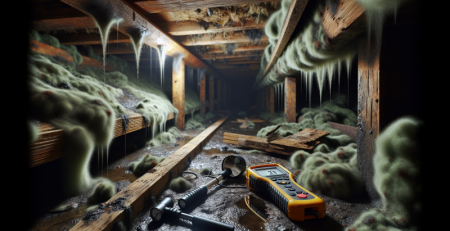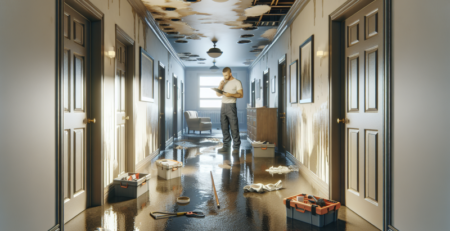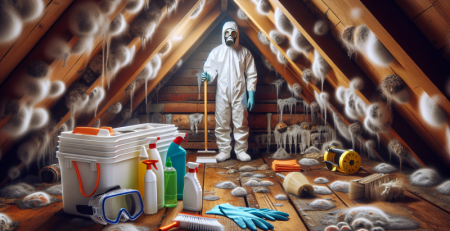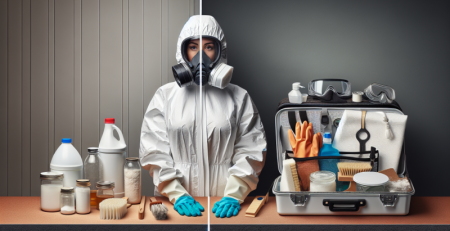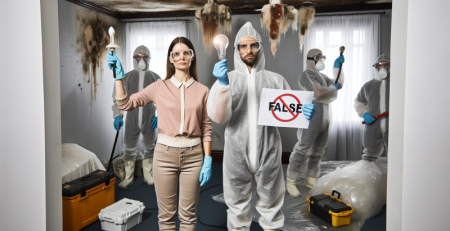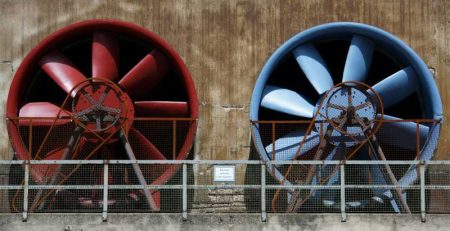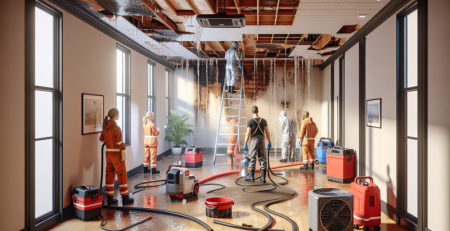How to Safeguard Your Home from Fire Risks
In today’s world, ensuring the safety of your home from fire risks is more crucial than ever. With the increasing prevalence of wildfires and household accidents, understanding how to safeguard your home is essential for protecting your loved ones and property. Fire safety involves a combination of preventive measures, awareness, and preparedness. At Kraus Restoration, NJ’s leaders in water, mold, and fire damage restoration, we recognize the importance of being proactive. Our team of IICRC certified experts is dedicated to helping homeowners in Central and Northern NJ implement effective fire prevention strategies. From installing smoke detectors to creating an emergency escape plan, there are numerous ways to minimize fire hazards. With our 24/7 emergency services and rapid response, we are here to support you in maintaining a safe living environment. Call us today at (973) 886-2021 to learn more about how you can protect your home from fire risks.
Understanding Common Fire Hazards in the Home
Fire hazards in the home are a critical concern for homeowners and renters alike. Understanding these hazards is the first step in safeguarding your home from potential fire risks. According to the National Fire Protection Association (NFPA), in the United States, fire departments respond to a fire every 24 seconds, and home fires account for a significant portion of these incidents. By identifying common fire hazards, you can take proactive measures to reduce the risk of a fire breaking out in your home.
One of the most prevalent fire hazards is cooking equipment. The NFPA reports that cooking is the leading cause of home fires and home fire injuries. Unattended cooking, particularly when frying, is especially dangerous. It is essential to stay in the kitchen while cooking and to keep flammable materials, such as dish towels and paper products, away from the stovetop.
Another common fire hazard is heating equipment. Space heaters, fireplaces, and central heating systems can all pose risks if not maintained properly. According to the NFPA, heating equipment is the second leading cause of home fires. It is crucial to keep flammable materials at least three feet away from heating sources and to have your heating systems inspected regularly.
Electrical issues are also a significant fire hazard in homes. Faulty wiring, overloaded circuits, and the use of damaged electrical cords can lead to fires. The NFPA states that electrical failures or malfunctions are responsible for approximately 13% of home fires. To mitigate this risk, homeowners should ensure that their electrical systems are up to code, avoid overloading outlets, and replace any frayed or damaged cords.
Flammable liquids and chemicals are often found in garages and basements, making them another common fire hazard. Items such as gasoline, paint thinners, and cleaning agents should be stored in proper containers and kept away from heat sources. The NFPA advises that these substances should be stored in well-ventilated areas and away from ignition sources to prevent accidental fires.
Additionally, smoking materials are a leading cause of fire deaths in the home. Cigarettes, cigars, and pipes should never be smoked in bed or near flammable materials. It is essential to use deep, sturdy ashtrays and to ensure that smoking materials are completely extinguished before disposal.
Another overlooked fire hazard is clutter. Accumulated items, especially those made of paper or fabric, can fuel a fire and impede escape routes. Keeping your home organized and free of excessive clutter can significantly reduce fire risks.
Finally, the presence of smoke alarms and fire extinguishers is vital in any home. The NFPA recommends installing smoke alarms on every level of your home and testing them monthly. Fire extinguishers should be easily accessible and maintained regularly to ensure they are in working order.
In summary, understanding common fire hazards in the home is essential for preventing fires and ensuring the safety of your family. By being aware of the risks associated with cooking, heating equipment, electrical systems, flammable liquids, smoking materials, clutter, and the importance of smoke alarms and fire extinguishers, you can take proactive steps to protect your home.
For more information on fire safety and prevention, consider visiting the NFPA website at www.nfpa.org. Additionally, if you are interested in learning more about fire cleanup and restoration services, you can explore our fire cleanup services. For further assistance in safeguarding your home from fire risks, do not hesitate to contact us.
Creating a Fire Safety Plan for Your Family
Creating a fire safety plan for your family is an essential step in safeguarding your home from fire risks. A well-thought-out fire safety plan not only prepares your family for emergencies but also helps to minimize the potential damage and loss that can occur in the event of a fire. The first step in developing a fire safety plan is to conduct a thorough assessment of your home to identify potential fire hazards. This includes checking for faulty wiring, ensuring that smoke detectors are installed and functioning, and being aware of flammable materials that may be present in your living space.
Once you have identified potential risks, it is crucial to establish a clear evacuation plan. This plan should include multiple escape routes from each room in your home, ensuring that all family members are familiar with these paths. Designate a safe meeting place outside your home where everyone can gather after evacuating. This will help ensure that everyone is accounted for and reduce the risk of anyone re-entering the home during a fire. Regularly practicing your evacuation plan through fire drills can help reinforce these procedures and ensure that everyone knows what to do in an emergency.
In addition to evacuation routes, your fire safety plan should include information on how to use fire extinguishers and other fire suppression tools. Make sure that all family members know the location of fire extinguishers and understand how to operate them effectively. It is also beneficial to educate your family about the different types of fires and the appropriate methods for extinguishing them. For example, using water on an electrical fire can be extremely dangerous, so knowing the right approach is vital.
Another important aspect of your fire safety plan is to ensure that your home is equipped with working smoke detectors. These devices are your first line of defense against fire hazards. Test your smoke detectors monthly and replace the batteries at least once a year. Additionally, consider installing carbon monoxide detectors, as this odorless gas can also pose a significant risk to your family’s safety.
Communication is key when developing a fire safety plan. Make sure to discuss the plan with all family members, including children, so that everyone understands their role in the event of a fire. Use simple language and visuals to help younger children grasp the concepts. It may also be helpful to create a written copy of the plan and place it in a visible location in your home.
Finally, review and update your fire safety plan regularly. As your family grows or changes, so too may your fire risks and evacuation needs. Keeping your plan current will ensure that it remains effective and relevant. For more information on fire safety and prevention, consider reaching out to professionals who specialize in fire cleanup and safety. They can provide valuable insights and resources to help you create a comprehensive fire safety plan tailored to your family’s needs. By taking these proactive steps, you can significantly enhance your family’s safety and preparedness in the face of fire risks.
Installing Smoke Detectors: Best Practices
When it comes to safeguarding your home from fire risks, one of the most critical steps you can take is to install smoke detectors. These devices are essential for early detection of smoke and fire, providing you and your family with precious moments to escape in the event of a fire. To ensure that your smoke detectors function effectively, it is important to follow best practices during installation.
First and foremost, choose the right type of smoke detector for your home. There are two main types: ionization smoke detectors, which are more responsive to flaming fires, and photoelectric smoke detectors, which are better at detecting smoldering fires. Many experts recommend using a combination of both types to maximize safety.
Next, consider the placement of your smoke detectors. The National Fire Protection Association recommends installing smoke detectors on every level of your home, including the basement and outside each sleeping area. Additionally, it is advisable to place smoke detectors in hallways and common areas where they can be easily heard. For optimal performance, install smoke detectors high on walls or ceilings, as smoke rises. If you are installing a detector on the ceiling, keep it at least four inches away from the nearest wall. If you are placing it on a wall, it should be installed between four and twelve inches from the ceiling.
Regular maintenance is crucial for ensuring that your smoke detectors remain functional. Test your smoke detectors monthly by pressing the test button. If the alarm does not sound, replace the batteries or the entire unit if necessary. It is also important to replace the batteries at least once a year, and the smoke detectors themselves every ten years, as they can become less effective over time.
In addition to regular testing and maintenance, it is wise to create a fire escape plan that includes your smoke detectors. Make sure all family members know the sound of the alarm and what to do when it goes off. Practice your escape plan regularly, so everyone knows the quickest and safest routes out of the house.
Furthermore, avoid placing smoke detectors in areas where they may be triggered by cooking smoke or steam, such as near kitchens or bathrooms. This can lead to false alarms, which may cause people to ignore the alarms when they are truly needed.
Lastly, consider integrating your smoke detectors with a home security system. Many modern systems allow for smoke detectors to be monitored remotely, sending alerts to your phone or a monitoring service if smoke is detected. This can provide an added layer of safety, especially if you are away from home.
By following these best practices for installing smoke detectors, you can significantly enhance the safety of your home and protect your loved ones from fire risks. For more information on fire safety and restoration services, visit fire cleanup or learn about our services to ensure your home remains a safe haven. Additionally, if you have any questions or need assistance, feel free to contact us for expert advice and support.
The Importance of Fire Extinguishers and Their Placement
Fire safety is a critical aspect of safeguarding your home from potential fire risks. One of the most effective tools in fire prevention and response is the fire extinguisher. Understanding the importance of fire extinguishers and their proper placement can significantly enhance your home’s safety measures. Fire extinguishers serve as the first line of defense against small fires, allowing you to tackle a fire before it escalates into a larger, uncontrollable blaze. They are designed to combat various types of fires, categorized by the materials that are burning. For instance, Class A extinguishers are effective against ordinary combustibles like wood and paper, while Class B extinguishers are meant for flammable liquids such as gasoline or oil. Having the right type of extinguisher readily available can make a crucial difference in an emergency situation.
Proper placement of fire extinguishers is equally important. It is recommended to install extinguishers in easily accessible locations, such as near exits, kitchens, and garages, where the likelihood of a fire starting is higher. Additionally, they should be mounted at a height that is easily reachable, typically between 3.5 to 5 feet above the ground. It is also essential to ensure that everyone in the household knows the location of the extinguishers and how to use them effectively. Regular maintenance checks are necessary to ensure that the extinguishers are in working order, including checking the pressure gauge and ensuring that the pin is intact. In case of a fire, knowing how to use the extinguisher can save valuable time. The acronym PASS can help you remember the steps: Pull the pin, Aim low, Squeeze the handle, and Sweep from side to side.
In addition to fire extinguishers, it is vital to have a comprehensive fire safety plan in place. This includes having smoke detectors installed throughout your home, creating an escape route, and conducting regular fire drills with your family. For more information on how to enhance your home’s fire safety measures, consider exploring our services or contacting us for expert advice on fire safety. By taking proactive steps to ensure the presence and proper placement of fire extinguishers, you can significantly reduce the risk of fire-related incidents in your home. Remember, being prepared is the key to protecting your loved ones and your property from the devastating effects of fire.
Regular Maintenance: Checking Electrical Systems
One of the most critical aspects of safeguarding your home from fire risks is ensuring that your electrical systems are in optimal condition. Regular maintenance of these systems is essential to prevent electrical fires, which can be devastating and life-threatening. Over time, wear and tear, outdated wiring, and improper installations can lead to hazardous situations. Therefore, it is vital to conduct routine checks on your electrical systems to identify potential issues before they escalate into serious problems.
Start by inspecting your electrical panels and circuit breakers. Look for any signs of damage, such as rust, corrosion, or burn marks. If you notice any of these signs, it is crucial to contact a licensed electrician to assess the situation. Additionally, ensure that all circuit breakers are functioning correctly and that they are not tripping frequently, as this can indicate an overloaded circuit or a fault in the wiring.
Next, examine your outlets and switches. Check for any discoloration, which may suggest overheating, and ensure that all outlets are securely mounted. Loose outlets can create arcing, which poses a significant fire risk. If you have any outlets that are not in use, consider installing tamper-resistant outlets to prevent accidental contact, especially in homes with young children.
Another important aspect of electrical maintenance is checking the condition of your wiring. If your home is older, it may still have outdated aluminum wiring, which is more prone to overheating than modern copper wiring. If you suspect that your home has aluminum wiring, consult with a professional to evaluate the safety of your electrical system. Furthermore, ensure that all wiring is properly insulated and that there are no exposed wires, as these can easily lead to short circuits and fires.
It is also essential to pay attention to the appliances and devices you use in your home. Regularly inspect cords and plugs for any signs of wear or damage. Frayed cords can create sparks and lead to fires, so replace any damaged cords immediately. Additionally, avoid overloading power strips and extension cords, as this can create a fire hazard. Instead, use them sparingly and ensure that they are rated for the devices you are connecting.
Consider implementing a schedule for regular electrical inspections. Depending on the age of your home and the condition of your electrical systems, you may want to have a professional electrician conduct a thorough inspection every few years. This proactive approach can help identify potential issues early and ensure that your home remains safe from electrical fires.
In addition to these checks, it is wise to install smoke detectors throughout your home. Ensure that they are functioning correctly and replace the batteries at least once a year. Smoke detectors are your first line of defense against fire, providing early warning that can save lives.
Lastly, educate your family about fire safety and the importance of reporting any electrical issues immediately. Encourage everyone to be vigilant and to recognize the signs of potential electrical problems, such as flickering lights or unusual smells. By fostering a culture of safety in your home, you can significantly reduce the risk of electrical fires.
In conclusion, regular maintenance and checking of your electrical systems are vital components of fire risk prevention. By staying proactive and addressing any issues promptly, you can protect your home and loved ones from the devastating effects of electrical fires. For more information on safeguarding your home, consider exploring our services or contact us for expert advice.
Safe Cooking Practices to Prevent Kitchen Fires
Cooking is one of the most common activities in our homes, but it also poses a significant risk for fire hazards. To ensure that your kitchen remains a safe environment, it is essential to adopt safe cooking practices that can prevent kitchen fires. The first step in fire prevention is to maintain a clean cooking area. Grease buildup on stovetops, ovens, and surrounding surfaces can ignite and lead to a fire. Regularly cleaning these areas not only reduces the risk of fire but also promotes a healthier cooking environment.
When cooking, it is crucial to stay attentive and never leave cooking food unattended. Many kitchen fires start when food is left on the stove or in the oven without supervision. If you must leave the kitchen, even for a short period, it is wise to turn off the heat or take the pot off the burner. Additionally, using timers can help you keep track of cooking times, ensuring that you do not forget about your food.
Another important aspect of safe cooking is to keep flammable materials away from heat sources. Items such as dish towels, paper towels, and wooden utensils should be stored at a safe distance from the stove. It is also advisable to wear appropriate clothing while cooking. Loose-fitting clothes can easily catch fire, so it is best to wear fitted clothing and avoid long sleeves that can brush against hot surfaces.
When using oil for frying, it is essential to monitor the temperature closely. Overheated oil can ignite, leading to a dangerous fire. If a fire does occur while frying, it is crucial to remember not to use water to extinguish it, as this can cause the fire to spread. Instead, cover the pan with a metal lid or use a fire extinguisher rated for grease fires. Having a fire extinguisher readily available in the kitchen is a smart precaution. Ensure that everyone in the household knows where it is located and how to use it.
In addition to these practices, it is important to use appliances safely. Always follow the manufacturer’s instructions for any cooking equipment, and ensure that appliances are in good working condition. Faulty wiring or malfunctioning appliances can pose a significant fire risk. If you notice any issues, such as frayed cords or unusual smells, it is best to unplug the appliance and have it repaired or replaced.
Lastly, educating all household members about kitchen safety is vital. Children should be taught the dangers of cooking and the importance of staying away from the stove while adults are cooking. Establishing a safe cooking environment involves everyone in the household, ensuring that everyone understands the risks and knows how to respond in case of an emergency.
By implementing these safe cooking practices, you can significantly reduce the risk of kitchen fires and protect your home. For more information on fire safety and prevention, you can visit our about page or explore our fire cleanup services. If you have any questions or need assistance, feel free to contact us.
Proper Storage of Flammable Materials
Proper storage of flammable materials is a critical aspect of fire safety in any home. Flammable materials can include a wide range of substances, such as cleaning products, paints, solvents, and fuels. These items can easily ignite and lead to devastating fires if not stored correctly. To minimize the risk of fire, it is essential to follow specific guidelines for the safe storage of these materials.
First and foremost, it is vital to keep flammable materials away from heat sources. This includes stoves, heaters, and any other appliances that generate heat. Ideally, these materials should be stored in a cool, dry place that is well-ventilated. A garage or shed can be suitable, but it is crucial to ensure that these areas are not exposed to direct sunlight or extreme temperatures, as this can increase the risk of ignition.
When storing flammable liquids, always use appropriate containers. Original containers are often designed to safely hold these substances, but if you need to transfer them, make sure to use containers that are specifically labeled for flammable materials. These containers should be tightly sealed to prevent leaks and should be made of materials that can withstand the contents without degrading. Additionally, it is advisable to store these containers on shelves that are at least 18 inches off the ground to avoid potential spills and to keep them away from areas where they could be knocked over.
Labeling is another essential aspect of proper storage. Clearly label all containers with the contents and any associated hazards. This not only helps in identifying the materials quickly but also ensures that anyone handling these items understands the risks involved. In case of an emergency, having clearly labeled materials can assist firefighters and emergency responders in managing the situation effectively.
It is also important to limit the quantity of flammable materials stored at home. Only keep what is necessary for your household needs. Excessive amounts of flammable substances can increase the risk of fire and complicate cleanup efforts in the event of an incident. Regularly check your inventory of flammable materials and dispose of any that are no longer needed or are expired. Follow local regulations for the safe disposal of hazardous materials to ensure that they do not pose a risk to your home or the environment.
In addition to proper storage practices, consider the layout of your storage area. Ensure that flammable materials are stored away from other chemicals that may react with them. For example, keep oxidizers away from flammable liquids, as this can create a dangerous situation. Organizing your storage area can help prevent accidents and make it easier to access materials when needed.
Finally, it is advisable to install smoke detectors and fire extinguishers in areas where flammable materials are stored. Smoke detectors can provide early warning in case of a fire, while fire extinguishers can help control small fires before they escalate. Make sure that everyone in your household knows where these safety devices are located and how to use them.
By following these guidelines for the proper storage of flammable materials, you can significantly reduce the risk of fire in your home. For more information on safeguarding your home from fire risks, consider exploring our services or contacting us for expert advice. Remember, fire safety is a shared responsibility, and taking proactive steps can protect your home and loved ones from potential hazards.
Fire-Resistant Building Materials for Homeowners
When it comes to safeguarding your home from fire risks, one of the most effective strategies is to utilize fire-resistant building materials. These materials are specifically designed to withstand high temperatures and slow the spread of flames, providing crucial time for occupants to escape and for firefighters to arrive. Homeowners should consider incorporating a variety of fire-resistant materials in both the construction and renovation of their homes to enhance safety and reduce fire hazards.
One of the most common fire-resistant materials is concrete. Known for its durability and strength, concrete can withstand high temperatures and is not easily ignited. It is often used in foundations, walls, and even roofing systems. Additionally, concrete can be combined with other materials to create fire-resistant composites that offer both structural integrity and aesthetic appeal.
Another excellent option is brick. Brick is a natural fire-resistant material that has been used for centuries in construction. Its dense composition allows it to absorb heat without igniting, making it an ideal choice for exterior walls and chimneys. Brick not only provides fire resistance but also adds a timeless aesthetic to homes, making it a popular choice among homeowners.
Steel is also a highly fire-resistant material that is increasingly used in modern construction. Unlike wood, steel does not burn, and it can withstand high temperatures without losing its structural integrity. Steel framing is becoming a popular choice for both residential and commercial buildings, as it offers a combination of strength, durability, and fire resistance. Homeowners should consider using steel for structural components such as beams, columns, and even roofing systems.
In addition to these materials, homeowners can also look into fire-resistant insulation options. Traditional insulation materials can be flammable, but there are alternatives available that provide better fire resistance. Mineral wool insulation, for example, is made from natural or recycled materials and can withstand high temperatures without melting or igniting. This type of insulation not only helps to protect against fire but also provides excellent thermal performance, making it a smart choice for energy efficiency.
Another innovative option is the use of fire-retardant treated wood. While wood is inherently combustible, treating it with fire-retardant chemicals can significantly improve its fire resistance. This treatment can be applied to various types of wood used in construction, including framing, decking, and siding. Homeowners should ensure that any treated wood they use is compliant with local building codes and standards.
When it comes to roofing materials, homeowners have several fire-resistant options to choose from. Metal roofing is one of the best choices, as it is non-combustible and can reflect heat away from the home. Additionally, clay and concrete tiles are also fire-resistant and can provide a beautiful, durable roofing solution. These materials not only enhance the fire safety of a home but also contribute to its overall aesthetic appeal.
It is also essential to consider the exterior finishes of a home. Using fire-resistant siding materials, such as fiber cement or stucco, can help protect the home from external fire threats. Fiber cement siding is made from a mixture of cement, sand, and cellulose fibers, making it highly resistant to fire. Stucco, on the other hand, is a cement-based material that provides excellent fire resistance and can be applied in various textures and colors to enhance the home’s curb appeal.
In addition to selecting fire-resistant building materials, homeowners should also focus on maintaining defensible space around their properties. This involves creating a buffer zone by clearing flammable vegetation and debris from around the home. By combining fire-resistant materials with proper landscaping practices, homeowners can significantly reduce the risk of fire damage.
Furthermore, it is crucial for homeowners to stay informed about local building codes and regulations regarding fire safety. Many areas have specific requirements for fire-resistant materials, especially in regions prone to wildfires. Consulting with professionals who specialize in fire safety and building design can help homeowners make informed decisions about the materials they choose.
In conclusion, incorporating fire-resistant building materials into your home is a proactive approach to safeguarding your property from fire risks. By selecting materials such as concrete, brick, steel, fire-resistant insulation, treated wood, and non-combustible roofing options, homeowners can create a safer living environment. Additionally, maintaining defensible space and adhering to local building codes will further enhance fire safety. For more information on how to protect your home from fire risks, consider reaching out to professionals who can provide guidance and support. Visit this link for more details about our services and expertise in fire safety. If you are interested in exploring our residential design projects, we invite you to check out our portfolio. For any inquiries or assistance, feel free to contact us.
Landscaping Tips to Reduce Fire Risk
When it comes to safeguarding your home from fire risks, landscaping plays a crucial role in creating a defensible space around your property. By implementing strategic landscaping techniques, you can significantly reduce the likelihood of a fire spreading to your home. One of the first steps is to create a defensible space that is clear of flammable materials. This involves maintaining a buffer zone around your home, ideally extending at least 30 feet. In this zone, remove any dead vegetation, leaves, and debris that can easily ignite. Additionally, consider using non-flammable materials for hardscaping features such as patios, walkways, and retaining walls.
Plant selection is another vital aspect of fire-resistant landscaping. Opt for fire-resistant plants that are less likely to ignite and can withstand heat. Native plants are often a great choice as they are adapted to the local climate and require less water, making them less susceptible to drought stress. Grouping plants according to their water needs can also help maintain a healthy landscape while reducing fire risk. For instance, placing low-water-use plants together can minimize the need for irrigation and reduce the amount of dry vegetation that can catch fire.
Creating vertical and horizontal spacing between plants is essential as well. This spacing helps to slow the spread of fire by creating gaps that fire cannot easily jump across. Trees should be pruned to maintain a height of at least six feet from the ground to prevent fire from climbing into the canopy. Additionally, keep shrubs and trees at least 10 feet apart to reduce the chance of fire spreading from one to another.
Mulching is another landscaping technique that can help reduce fire risk. While organic mulches can be flammable, using gravel or rock mulch can provide a non-combustible alternative. If you prefer organic mulch, ensure it is kept moist and maintained to prevent it from drying out and becoming a fire hazard.
Irrigation systems can also play a significant role in fire prevention. Installing a drip irrigation system can help keep your plants hydrated, especially during dry seasons. A well-watered landscape is less likely to catch fire, so consider incorporating irrigation into your landscaping plan.
Finally, consider the layout of your landscaping. Avoid planting dense vegetation close to your home, and instead, create open spaces that can act as firebreaks. This can include gravel paths or rock gardens that not only enhance the aesthetic appeal of your property but also serve as barriers to fire.
By following these landscaping tips, you can create a beautiful and functional outdoor space that also serves to protect your home from fire risks. For more information on how to enhance your home’s safety, visit our about page or explore our services to learn about fire cleanup and prevention strategies. If you have any questions or need assistance, feel free to contact us.
The Role of Home Insurance in Fire Safety
Home insurance plays a crucial role in fire safety, serving as both a financial safety net and a proactive measure to protect your home and belongings from the devastating effects of fire. While no homeowner wants to think about the possibility of a fire, understanding the importance of home insurance can significantly enhance your overall fire safety strategy. Fire can strike unexpectedly, and the aftermath can be overwhelming, both emotionally and financially. This is where home insurance comes into play, providing peace of mind and essential support in times of crisis.
One of the primary functions of home insurance is to cover the costs associated with damage caused by fire. In the event of a fire, the expenses can quickly escalate, including repairs to the structure, replacement of personal belongings, and even temporary living expenses if your home becomes uninhabitable. A comprehensive home insurance policy will typically cover these costs, allowing you to focus on recovery rather than financial burdens. It is essential to review your policy to ensure that it includes adequate coverage for fire damage, as well as any additional living expenses that may arise during the recovery process.
In addition to financial protection, home insurance can also encourage homeowners to take proactive measures to enhance fire safety. Many insurance providers offer discounts for homes equipped with fire safety features such as smoke detectors, fire alarms, and sprinkler systems. By investing in these safety measures, homeowners not only reduce their risk of fire but also potentially lower their insurance premiums. This creates a win-win situation where homeowners are motivated to improve their fire safety while also benefiting financially.
Moreover, home insurance can provide access to valuable resources and support during a fire emergency. Many insurance companies offer risk assessment services that can help homeowners identify potential fire hazards in their homes. By working with professionals, homeowners can receive tailored advice on how to mitigate these risks, whether through home modifications, better maintenance practices, or the installation of fire-resistant materials. This proactive approach not only helps in reducing the likelihood of a fire but also strengthens the overall safety of the home.
Another critical aspect of home insurance in relation to fire safety is the claims process. In the unfortunate event of a fire, navigating the claims process can be daunting. However, having a reliable insurance policy in place can streamline this process, ensuring that you receive the necessary funds to begin repairs and replace lost items promptly. It is advisable to document your belongings and keep an updated inventory, as this can significantly expedite the claims process. Many insurance companies now offer digital tools to help homeowners manage their inventories and claims, making it easier to recover after a fire incident.
Furthermore, home insurance can also cover liability claims if someone is injured on your property due to a fire-related incident. This aspect of coverage is often overlooked but is crucial for protecting homeowners from potential lawsuits. If a guest suffers injuries due to a fire that originated in your home, having adequate liability coverage can safeguard you from significant financial repercussions.
In conclusion, home insurance is an integral part of any comprehensive fire safety strategy. It not only provides financial protection in the event of a fire but also encourages homeowners to take proactive steps to enhance their safety. By understanding the benefits of home insurance, homeowners can better prepare for the unexpected and ensure that they are equipped to handle the aftermath of a fire. For more information on how to protect your home and the services available, you can visit this page or explore our services to learn more about fire safety measures. Additionally, if you have any questions or need assistance, feel free to contact us for expert guidance.
Educating Your Family on Fire Safety Procedures
Educating your family on fire safety procedures is a crucial step in safeguarding your home from fire risks. Fire can spread rapidly, and having a well-informed family can make a significant difference in preventing disasters and ensuring safety. Begin by discussing the importance of fire safety with your family members. Explain how fires can start from various sources, such as cooking, electrical malfunctions, or even candles. Make sure everyone understands the potential risks associated with these common household items.
Next, create a comprehensive fire safety plan that includes escape routes and meeting points. Conduct regular fire drills so that everyone knows how to react in case of an emergency. Practice using different exits and ensure that all family members, including children, can navigate the escape routes confidently. It is also essential to teach your family about the sound of smoke alarms and what to do when they hear one. Discuss the importance of not ignoring alarms and the need to evacuate immediately.
Incorporate discussions about fire prevention into your daily life. Teach your family about safe cooking practices, such as never leaving the stove unattended and keeping flammable materials away from heat sources. Discuss the importance of electrical safety, including not overloading outlets and regularly checking cords for damage. Encourage your family to be vigilant about potential fire hazards in and around your home.
Additionally, ensure that your home is equipped with functioning smoke detectors and fire extinguishers. Show your family how to use a fire extinguisher and explain the different types available for various types of fires. Regularly check and replace batteries in smoke detectors, and establish a routine for testing them monthly. This proactive approach will help instill a sense of responsibility in your family regarding fire safety.
Consider involving your family in fire safety education programs or workshops offered by local fire departments. These programs often provide valuable information and hands-on training that can enhance your family’s understanding of fire safety. Engaging in community resources not only educates your family but also fosters a sense of community awareness regarding fire risks.
Lastly, keep an open line of communication about fire safety. Encourage your family members to ask questions and express any concerns they may have. By fostering an environment where fire safety is openly discussed, you empower your family to take fire risks seriously and act responsibly. For more information on fire safety and how to protect your home, visit our about page or explore our fire cleanup services to learn how to respond effectively in case of a fire emergency.
Conducting Regular Fire Drills at Home
One of the most crucial steps in safeguarding your home from fire risks is to conduct regular fire drills. These drills are not just for schools or workplaces; they are essential for every household. A fire drill is a practice session that prepares you and your family for the event of a fire, ensuring that everyone knows what to do and where to go in case of an emergency. The importance of these drills cannot be overstated, as they can save lives and minimize injuries during a real fire incident.
To begin with, it is vital to establish a clear fire escape plan. This plan should outline the safest and quickest routes out of your home, taking into account the layout of your house and the locations of exits. Make sure that all family members are familiar with this plan. Designate a meeting point outside your home where everyone can gather after escaping. This will help ensure that everyone is accounted for and reduce confusion during an emergency.
Once you have your escape plan in place, it is time to practice. Schedule regular fire drills, ideally at least twice a year. Choose different times of day for these drills to simulate various scenarios, such as a fire occurring at night when everyone is asleep or during the day when family members are engaged in different activities. This will help everyone become accustomed to the escape routes and procedures, making them more effective in a real emergency.
During the fire drill, make sure to simulate the conditions of a real fire as closely as possible. This includes turning off lights, closing doors, and using a smoke alarm to signal the start of the drill. Encourage family members to stay low to the ground, as smoke rises, and to cover their mouths with a cloth to avoid inhaling smoke. Remind everyone to avoid using elevators and to use the stairs instead.
After completing the drill, gather everyone at the designated meeting point and conduct a debriefing session. Discuss what went well and what could be improved. This is an excellent opportunity to address any concerns or questions family members may have. It is also a chance to reinforce the importance of remaining calm and focused during an emergency.
In addition to practicing escape routes, it is essential to educate your family about fire safety. Teach them about the different types of fires and the appropriate ways to respond. For instance, explain the importance of not trying to extinguish a fire that is too large or out of control. Instead, emphasize the need to evacuate immediately and call emergency services. You can also discuss the importance of smoke detectors and how to test them regularly to ensure they are functioning correctly.
Another critical aspect of fire safety is ensuring that your home is equipped with the necessary fire safety equipment. This includes smoke detectors, fire extinguishers, and fire blankets. Make sure that smoke detectors are installed in every bedroom, hallway, and common area, and test them monthly to ensure they are working. Fire extinguishers should be placed in easily accessible locations, and family members should be trained on how to use them effectively.
Regular fire drills not only prepare your family for emergencies but also foster a culture of safety within your home. When everyone is aware of the risks and knows how to respond, it creates a sense of security and confidence. This proactive approach can significantly reduce the likelihood of panic and confusion during a real fire situation.
In conclusion, conducting regular fire drills at home is an essential component of fire safety. By establishing a clear escape plan, practicing regularly, educating your family, and ensuring that your home is equipped with the necessary safety equipment, you can significantly enhance your family’s preparedness for a fire emergency. Remember that the goal is to create a safe environment where everyone knows what to do and can act quickly and efficiently in the event of a fire. For more information on fire safety and prevention, you can visit our about page or explore our fire cleanup services. If you have any questions or need assistance, feel free to contact us.
The Benefits of Professional Fire Risk Assessments
When it comes to protecting your home from fire risks, one of the most effective strategies is to conduct a professional fire risk assessment. This comprehensive evaluation is designed to identify potential fire hazards, assess the effectiveness of existing fire safety measures, and provide actionable recommendations to enhance fire safety in your home. Engaging a qualified professional for this assessment offers numerous benefits that can significantly improve your home’s safety and security.
First and foremost, a professional fire risk assessment provides an expert analysis of your property. Trained professionals have the knowledge and experience to identify fire hazards that may not be immediately apparent to the average homeowner. They will examine various aspects of your home, including electrical systems, heating appliances, and storage practices, to pinpoint potential risks. This thorough examination ensures that no stone is left unturned in your quest for safety.
Another significant advantage of a professional fire risk assessment is the tailored recommendations that come with it. After identifying potential hazards, the assessor will provide you with a customized action plan that addresses your specific needs. This plan may include suggestions for improving fire detection systems, upgrading fire extinguishers, or implementing better storage practices for flammable materials. By following these expert recommendations, you can significantly reduce the risk of a fire occurring in your home.
In addition to enhancing safety, a professional fire risk assessment can also help you comply with local fire safety regulations. Many jurisdictions have specific requirements for fire safety in residential properties. A qualified assessor will be familiar with these regulations and can ensure that your home meets all necessary standards. This not only protects your family but also helps you avoid potential fines or legal issues related to non-compliance.
Moreover, conducting a fire risk assessment can provide peace of mind. Knowing that your home has been evaluated by a professional and that you are taking proactive steps to mitigate fire risks can alleviate anxiety for homeowners. This peace of mind is invaluable, especially for families with young children or elderly members who may be more vulnerable in the event of a fire.
Another benefit of a professional fire risk assessment is the potential for insurance savings. Many insurance companies offer discounts to homeowners who have taken proactive measures to reduce fire risks. By obtaining a professional assessment and implementing the recommended changes, you may qualify for lower premiums on your homeowner’s insurance policy. This not only saves you money but also reinforces your commitment to fire safety.
Furthermore, a professional fire risk assessment can enhance your home’s overall value. Prospective buyers are often more attracted to homes that have been evaluated for fire safety and have implemented necessary improvements. This can be a selling point if you ever decide to put your home on the market. A well-documented fire risk assessment can serve as evidence of your commitment to maintaining a safe living environment.
In addition to these benefits, a professional fire risk assessment can also facilitate better emergency preparedness. The assessment process often includes discussions about emergency evacuation plans and the importance of having a family fire safety plan in place. This proactive approach ensures that all household members are aware of what to do in the event of a fire, which can save lives.
Lastly, engaging a professional for a fire risk assessment can foster a culture of safety within your home. When you prioritize fire safety and take the necessary steps to mitigate risks, you set an example for your family. This culture of safety can extend beyond fire risks to other areas of home safety, creating a more secure living environment overall.
In conclusion, the benefits of a professional fire risk assessment are numerous and impactful. From expert hazard identification and tailored recommendations to compliance with regulations and potential insurance savings, the advantages are clear. By investing in a professional fire risk assessment, you are taking a significant step toward safeguarding your home from fire risks. To learn more about how to protect your home and family, consider exploring our services or contact us for further assistance. Your safety is our priority, and we are here to help you create a safer living environment.
Staying Informed: Keeping Up with Fire Safety Regulations
Fire safety regulations are essential for protecting your home and ensuring the safety of your family. Staying informed about these regulations is crucial for homeowners who want to minimize fire risks and enhance their preparedness. Fire safety codes and standards are established by local, state, and federal authorities, and they can vary significantly depending on your location. Understanding these regulations helps you comply with legal requirements and implement best practices for fire prevention.
One of the most effective ways to stay informed is to regularly check with your local fire department or fire marshal. They often provide resources and updates on fire safety regulations, including any changes that may affect residential properties. Many fire departments also offer community programs that educate homeowners about fire safety measures, such as installing smoke detectors, maintaining fire extinguishers, and creating evacuation plans. Engaging with these programs can provide valuable insights and practical tips for safeguarding your home.
Additionally, the National Fire Protection Association (NFPA) is a vital resource for homeowners seeking to understand fire safety regulations. The NFPA publishes a wealth of information, including codes and standards that govern fire safety practices. Their guidelines cover various aspects, from building construction to fire alarm systems, and they are widely recognized in the industry. By familiarizing yourself with NFPA standards, you can ensure that your home meets the necessary safety requirements.
Another important aspect of staying informed is understanding the role of insurance in fire safety. Homeowners insurance policies often have specific requirements regarding fire safety measures. Familiarizing yourself with these requirements can help you avoid potential issues when filing a claim. It is advisable to review your policy regularly and consult with your insurance agent to ensure that you are compliant with any fire safety regulations that may impact your coverage.
Moreover, technology plays a significant role in fire safety today. Smart home devices, such as smoke detectors and fire alarms, can provide real-time alerts and notifications in case of a fire. Staying updated on the latest advancements in fire safety technology can enhance your home’s protection. Many manufacturers offer apps that allow you to monitor your fire safety devices remotely, giving you peace of mind even when you are away from home.
Networking with local community groups or online forums focused on home safety can also be beneficial. These platforms often share information about fire safety regulations, best practices, and personal experiences. Engaging with others who prioritize fire safety can provide you with additional resources and support.
Finally, consider consulting with professionals who specialize in fire safety and prevention. Companies that offer fire cleanup services, such as fire cleanup, can provide insights into the latest regulations and safety measures. They can also help you assess your home for potential fire hazards and recommend improvements to enhance your safety.
In conclusion, staying informed about fire safety regulations is a proactive step every homeowner should take. By utilizing resources from local fire departments, the NFPA, and insurance providers, as well as embracing technology and community support, you can significantly reduce fire risks in your home. Regularly updating your knowledge and practices will not only help you comply with regulations but also ensure the safety and well-being of your family. For more information on how to protect your home from fire risks, visit our about page or explore our services to learn more about fire safety and prevention strategies.
FAQ: How to Safeguard Your Home from Fire Risks
Q1: What are the most common causes of house fires?
A1: The most common causes of house fires include cooking accidents, heating equipment malfunctions, electrical failures, and open flames from candles or fireplaces. It’s essential to be aware of these risks and take preventive measures.
Q2: How can I prevent kitchen fires?
A2: To prevent kitchen fires, never leave cooking food unattended, keep flammable items away from the stove, and regularly clean your cooking appliances to avoid grease buildup. Additionally, consider using a timer to remind you when to check on your food.
Q3: What fire safety equipment should I have in my home?
A3: Essential fire safety equipment includes smoke detectors, carbon monoxide detectors, fire extinguishers, and a fire blanket. Ensure that smoke detectors are installed in every bedroom and common area, and check their batteries regularly.
Q4: How often should I check my smoke detectors?
A4: You should test your smoke detectors monthly and replace the batteries at least once a year. Additionally, replace the entire smoke detector unit every 10 years to ensure optimal functionality.
Q5: What steps can I take to make my home more fire-resistant?
A5: To enhance your home’s fire resistance, consider using fire-retardant building materials, maintaining a defensible space around your property by clearing away dry vegetation, and ensuring that your roof and gutters are free of debris.
Q6: How can I create a fire escape plan for my family?
A6: To create a fire escape plan, identify two exits from each room, designate a meeting place outside, and practice the plan regularly with your family. Ensure that everyone knows how to escape quickly and safely.
Q7: What should I do if a fire breaks out in my home?
A7: If a fire breaks out, remain calm and follow your escape plan. If the fire is small and manageable, use a fire extinguisher to put it out. Otherwise, evacuate immediately, close doors behind you to contain the fire, and call emergency services from a safe location.
Q8: Are there any specific fire risks associated with holiday decorations?
A8: Yes, holiday decorations can pose fire risks, especially if they are flammable or if lights are used improperly. Always use flame-resistant decorations, avoid overloading electrical outlets, and turn off lights when you leave home or go to bed.
Q9: How can I educate my children about fire safety?
A9: Educate your children about fire safety by teaching them the dangers of fire, how to use emergency numbers, and the importance of following your fire escape plan. Conduct fire drills and encourage them to ask questions about fire safety.
Q10: Where can I find more resources on fire safety?
A10: You can find more resources on fire safety from organizations such as the National Fire Protection Association (NFPA), your local fire department, and various online safety websites that provide guidelines and tips for fire prevention.
By addressing these common questions, you can better prepare yourself and your family to safeguard your home from fire risks.

